*NURSING > EXAM > CNN Exam- Chronic Kidney Disease 22 Questions with Verified Answers,100% CORRECT (All)
CNN Exam- Chronic Kidney Disease 22 Questions with Verified Answers,100% CORRECT
Document Content and Description Below
CNN Exam- Chronic Kidney Disease 22 Questions with Verified Answers List the limitations of the modification diet of renal disease (MDRD) and Cockgraft-Gault equations - CORRECT ANSWER The major li... mitation for both equations is that at glomerular filtration rates above 60, their estimation is not accurate. The equation is much more accurate for stages II to V. Cockgraft-Gault does not take into account ethnicity or nutritional status. The MDRD is preferred because it has been extensively studied and takes into account other variables. MDRD is limited in that it only accounts for 1 race (black). Other minority groups are not accounted for and thus their GFR may not be truly representative. ***TAKE AWAY*** Both are less accurate with GFR greater than 60. List the Cockgraft-Gault equation - CORRECT ANSWER Calculated by the following: (140-age) x lean body mass (kg) / serum creatinine (mg/dl) x 72. The equation is further modified by multiplying the result by 0.85 for woman (as a way for accounting for the lower body mass). The Cockgraft-Gault equation is easily memorized and only requires one blood test to calculate, the serum creatinine. Limited by variances in the body mass (relies on serum creatinine for calculations). Can be over or under estimated based on GFR. It also loses accuracy in patients with amputated limbs, particularly the lower extremity List the Modification Diet of Renal Disease equation - CORRECT ANSWER Calculated by using: (Age) exp[-0.176] x (BUN [mg/dl]) exp[-0.170] x (Alb [g/dl]) exp[+0.318] x (0.762 if female0 x (1.18 if black) Complicated equation and shouldn't be memorized. -Regarded as being more accurate method -Widely studied and also accounts for nutrition and ethnicity -Limitations include losing accuracy at GFR greater than 60 and lab errors -Serum BUN and albumin required and if inaccurate or inconsistent, will be effected -Limited by patients with unusual body mass as is seen with obese, malnourished and amputees Describe appropriate dialysate calcium concentrations in patients on either hemodialysis or peritoneal dialysis - CORRECT ANSWER The dialysate concentration is normally set to 2.5 mEq/L. At this concentration, little or no calcium is exchanged between dialysate and the serum. In patients with elevated calcium levels a lower dialysate concentration will be needed to remove excess calcium. Conversely, if patients need calcium, a dialysate concentration of 3.5 mEq/L will provide calcium to the patient. Initial therapy to raise the serum calcium level is through both calcium and vitamin D supplementation. Describe the kidney's role in calcium and phosphorus homeostasis - CORRECT ANSWER The kidney is instrumental in excreting excess phosphorous and producing the active form of vitamin D, called calcitriol. Calcitriol is a hormone which travels to the gut and aids in both phosphorus and calcium absorption. Moreover, calcium phosphorus is regulated by the hormones PTH (parathyroid hormone). PTH is released from the parathyroid gland and functions to elevate serum calcium levels and lower phosphorus levels. ***Note that the kidneys are involved in both phosphorus excretion (under influence of PTH) and phosphorus absorption via calcitriol. Discuss the pathophysiology of aluminum toxicity in patients with chronic kidney disease - CORRECT ANSWER Aluminum is excreted by the kidneys. In patients with renal disease, the ability to excrete aluminum is hindered. Aluminum toxicity was a much larger problem when aluminum based phosphate binders were used. The aluminum would be absorbed by the gut and accumulate over time. Aluminum causes the following abnormalities: - acute toxicity - dementia - osteomalacia - anemia - hypercalcemia (by displacing calcium in bony matrix) Treatment of acute aluminum toxicity is via hemodialysis with low aluminum dialysate concentration. Osteomalacia, dementia, anemia and hypercalcemia are products of chronic exposure to aluminum. Prevention is huge with avoidance of aluminum based phosphate binders and frequent monitoring of dialysis water system for elevated aluminum levels. Describe the role of parathyroid hormone (PTH) on calcium and phosphorus - CORRECT ANSWER PTH is stimulated by 2 mechanisms: either a low serum calcium level or elevated phosphorus PTH acts to increase serum calcium and lower phosphorus. It increases calcium by 2 methods: - Stimulates the release of calcium from bone (body's reserve of calcium stores) - Stimulates the kidney to release calcitriol (active form of Vitamin D). Calcitriol will raise the serum calcium level by increasing calcium absorption in the gut. PTH also acts to decrease serum phosphorus. Accomplishes this by acting on the kidneys to excrete phosphorus in the urine. In patients with CKD, PTH is elevated because the kidneys do not respond appropriately. Kidneys can neither produce calcitriol or excrete phosphorus. Thus, PTH levels rise (also known as secondary hyperparathyroidism) and a viscous cycle ensues. Define adynamic bone disease - CORRECT ANSWER Adynamic bone disease occurs when bone turnover is absent. The pathophysiology is as follows: Parathyroid hormone levels are increased in response to low serum calcium and renal failure. Therapy is begun with calcium containing phosphate binders and calcitriol. The resulting increase in calcium and lowering of phosphorus causes PTH levels to decrease to near normal levels. This causes bone to be essentially dormant. The physiology of a patient with chronic kidney disease dictates that PTH levels at 1.5-2 times normal are needed in order to maintain healthy bone turnover. Otherwise, bone becomes dormant and essentially inactive/ When treating patients for hyperphosphatemia and vitamin D deficiency, care must be taken not TOO overzealous so as not to reduce PTH levels to normal. Define metastatic calcification - CORRECT ANSWER Local or wide deposition of predominately calcium salts in otherwise normal tissue in the setting of hypercalcemia This occurs when the calcium and phosphorus levels are high. High is defined by a calcium-phosphorus product of greater than 70. Accomplished with diet restricted for phosphorus and judicious use of phosphate binders. Describe the importance of calcium phosphorus product - CORRECT ANSWER When calcium and phosphorus levels reach a certain point, they can combine in the bloodstream and precipitate out. The form mineral deposits in organs as well as blood vessels which is injurious to their function. Nephrologists must keep track of the calcium phosphorus product or simply multiply the serum calcium with the serum phosphorus. If the product exceeds 70, the patient is at increased risk of calcium phosphorus deposition. It is imperative to monitor the calcium phosphorus product in all patients with CKD with interventions to lower that product is necessary. Describe the role of vitamin D on calcium and phosphorus - CORRECT ANSWER The activate form of vitamin D, calcitriol is produced by the kidneys. Calcitriol is released in response to low serum calcium levels and under the influence of parathyroid hormone. Calcitriol acts on the gut to increase absorption of both phosphorus and calcium. In patients with CKD, calcitriol is not produced adequately. Patients with CKD and low calcium levels are frequently given supplemental calcitriol. Define osteomalacia - CORRECT ANSWER Low bone turnover secondary to aluminum deposition. Define calciphylaxis - CORRECT ANSWER Rare complication of metastatic calcification Occurs when the calcium phosphorus product is high. Calcium precipitates in arteries and tissues including vital organs and skin. In contrast to metastatic calcification, calciphylaxis causes tissue ischemia. Patients can prevent with gangrenous skin (which becomes infected) Treatment is primary prevention of elevation of calcium phosphorus product Define renal osteodystrophy - CORRECT ANSWER General term which included many aspects of renal bone disease- -ostetis fibrosa cystica- -exists when there is increased bone turnover from elevated PTH -osteomalacia- -low bone turnover in combination with aluminum deposition -adynamic bone disease- -bone turnover is low secondary to reduced parathyroid hormone -mixed osteodystrophy- -mixture of both high and low bone turnover Define Osteitis Fibrosa Cystica: - CORRECT ANSWER Term used to define excess bone turnover in response to both elevated PTH and low calcitriol. Driving force behind this response is elevated phosphorus levels and low calcium. The elevation in PTH causes calcium to be released from bone resulting in what is termed increased bone turnover. Increased bone turnover results in weakened bone structure and an osteoporosis of sorts. Correction of increased bone turnover and osteitis fibrosa cystica is through administration of phosphate binders, consumption of low phosphorus diets and supplementation of calcitriol. Describe the currently available phosphate binders and their mechanism of action - CORRECT ANSWER 3 kinds Aluminum based phosphate binders- used to bind phosphate in the gut and prevent its absorption. However significant side effects of aluminum including osteomalacia and dementia have eliminated aluminum as a viable option. Calcium based phosphate binders- most commonly used. Bind phosphorus in the guy with some absorption of elemental calcium. Main side effect of calcium based binders is hypercalcemia. Finally- non-calcium based binders- new to market and increasingly popular. Polymers bind to intestinal phosphors and have few side effects in contrast with others. List the limitations of dietary calcium intake in patients with elevated phosphorus levels - CORRECT ANSWER Limits of total daily calcium intake should not exceed 2000 mg (2 grams). Furthermore, only 1500 mg of elemental calcium is permitted daily when given a calcium based phosphate binder. The rationale for limiting calcium intake is excessive intake will result in increased calcium absorption. Of too much is absorbed, the calcium phosphorus product may exceed the set limits of 70. A calcium phosphorus product of greater than 70 leaves the patient susceptible to metastatic calcification and the more rare condition of calciphylaxis. Describe how phosphate binders should be used in patients with chronic kidney disease - CORRECT ANSWER Foremost, phosphorus levels should be kept at normal to high normal levels. Dietary restriction should be the first attempt at reducing phosphorus levels. However in patients with persistently elevated phosphorus despite dietary restriction, phosphate binders should be used. In patients with chronic kidney disease stage III to IV calcium based binders are the first choice. Calcium based binders are preferred in this patient population for the supplemental calcium will aid in preserving bone integrity and reducing PTH levels. In patients with CKD stage V, either calcium based or non-calcium based binders are preferred. Difference is that in patients with CKD stage 5, they often have a higher phosphorus level. Any supplemental calcium absorbed with calcium based binders may precipitate metastatic calcification. Non-calcium based binders are equally as effective in patients with CKD stage 5. Describe how metabolic acidosis alters normal bone homeostasis - CORRECT ANSWER Metabolic acidosis contributes to renal bone disease by causing the release of calcium from bone. In patients with chronic kidney disease, amino acids are not readily excreted and the acids accumulate. The normal buffer for acids is bicarbonate. When the bicarbonate is exhausted, bone serves as a buffer. In acting as a buffer, bone releases calcium while absorbing the acids. Thus, bone is devoid of its vital elements making it weaker and more susceptible to fractures. Correction of acidosis will allow for proper buffering of acids and allow calcium to remain in the bony matrix. List the current recommendations on dietary phosphorus restriction in patients with chronic kidney disease - CORRECT ANSWER Most dietary phosphorus comes in the form of protein. Therefore, dietary protein restriction would greatly aid in lowering phosphorus intake. However this only applies to patients with CKD stages 2-5. In patients with stage V CKD, protein restriction is known to cause malnutrition. In fact, patients on HD frequently need more protein to ensure adequate nutrition. Describe how to treat hypocalcemia in patients with chronic kidney disease - CORRECT ANSWER In patients with low serum calcium levels care must be taken to ensure that the patient is not symptomatic. Signs of low calcium include tetany, bronchospasm, muscle twitching and most severely seizures. Supplemental calcium should come in the form of oral calcium salts and vitamin D. Caution should be used to not be too overzealous as hypercalcemia and precipitation of calcium deposition in tissues and vessels. List the limitations of vitamin D supplementation in patients with chronic kidney disease - CORRECT ANSWER Patient with chronic kidney disease and elevated PTH levels with concomitant low vitamin D stores will need vitamin D supplementation. Vitamin D is administered in oral form and it will increase absorption of calcium and phosphorus. [Show More]
Last updated: 1 year ago
Preview 1 out of 7 pages
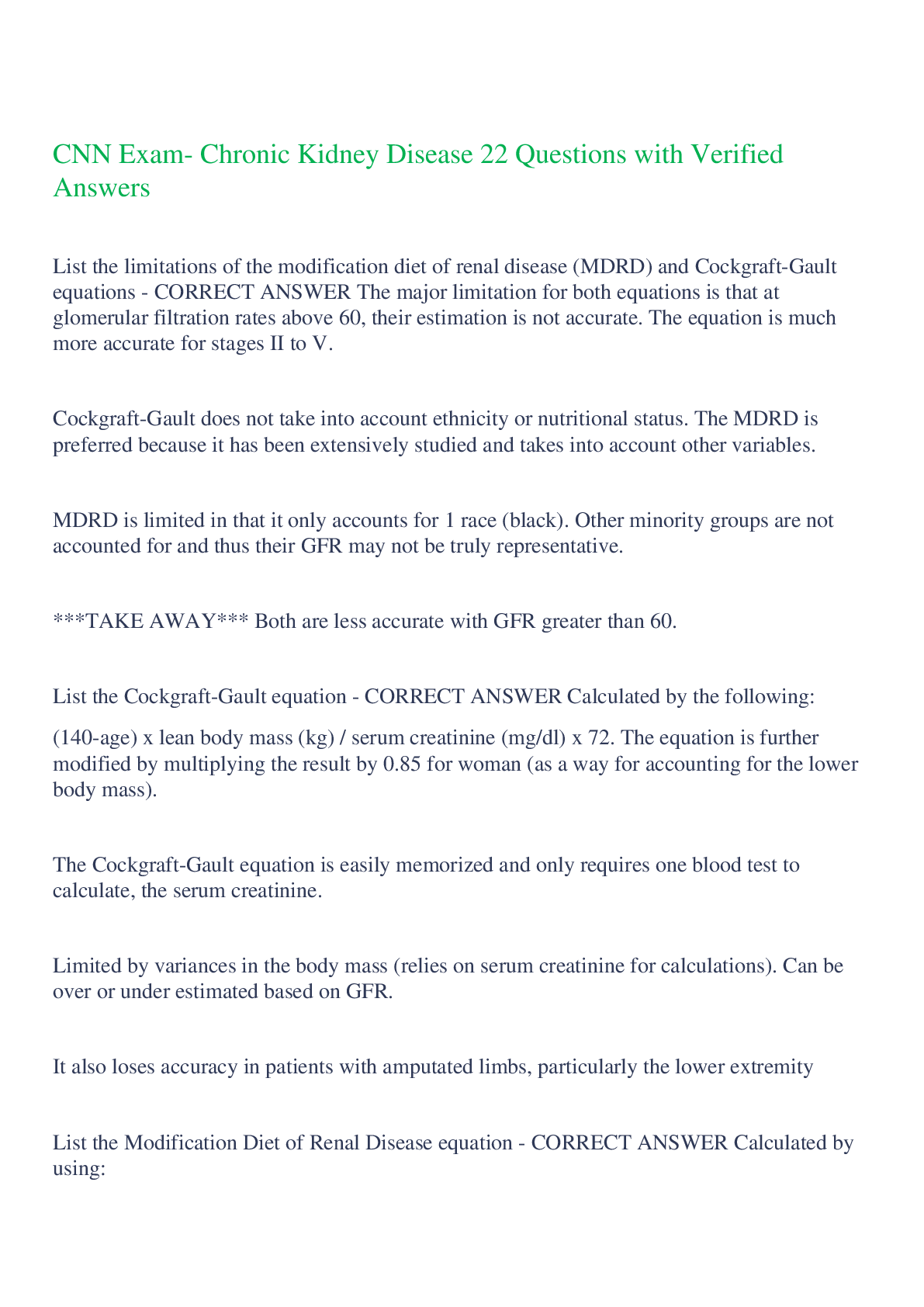
Buy this document to get the full access instantly
Instant Download Access after purchase
Buy NowInstant download
We Accept:

Reviews( 0 )
$7.50
Can't find what you want? Try our AI powered Search
Document information
Connected school, study & course
About the document
Uploaded On
Oct 27, 2023
Number of pages
7
Written in
Additional information
This document has been written for:
Uploaded
Oct 27, 2023
Downloads
0
Views
65


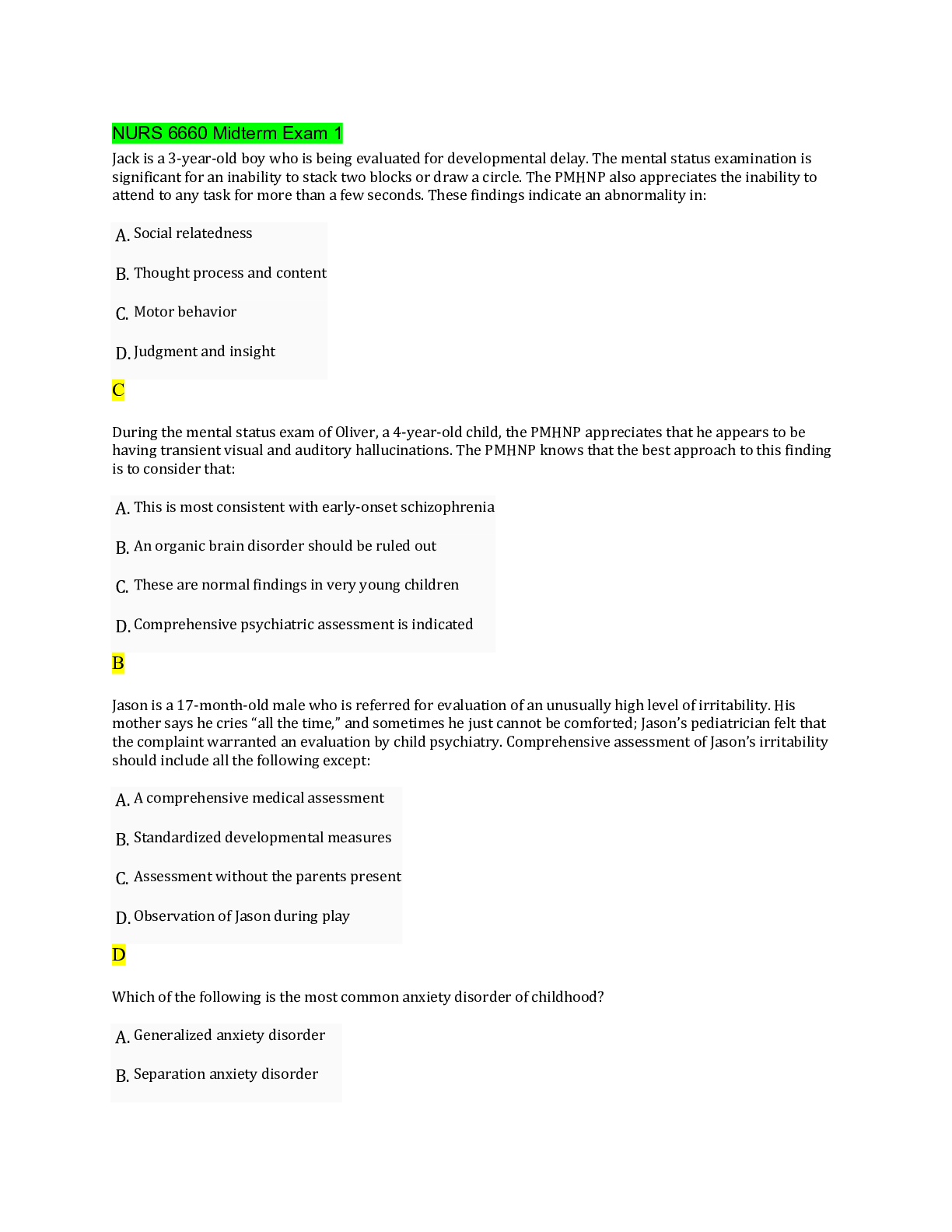
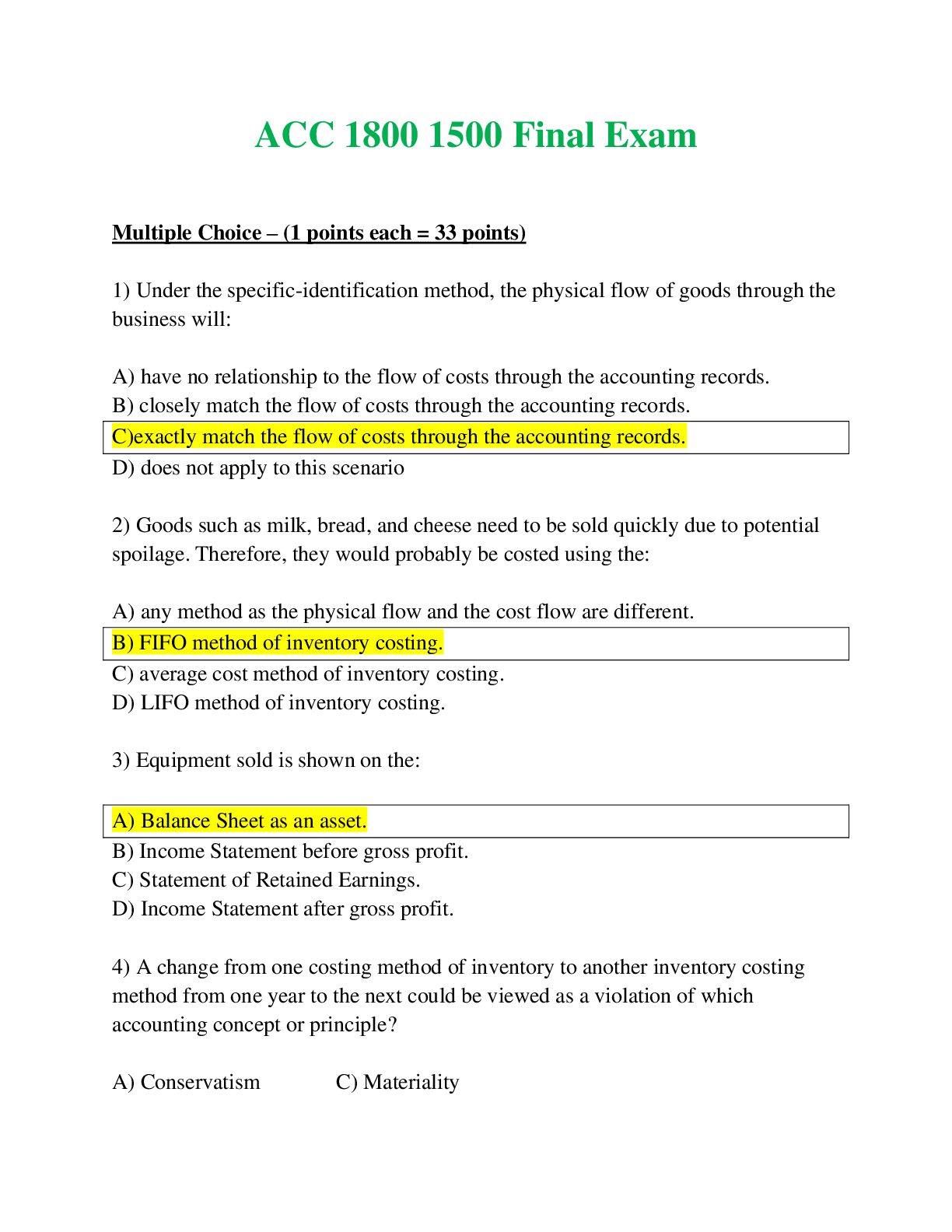

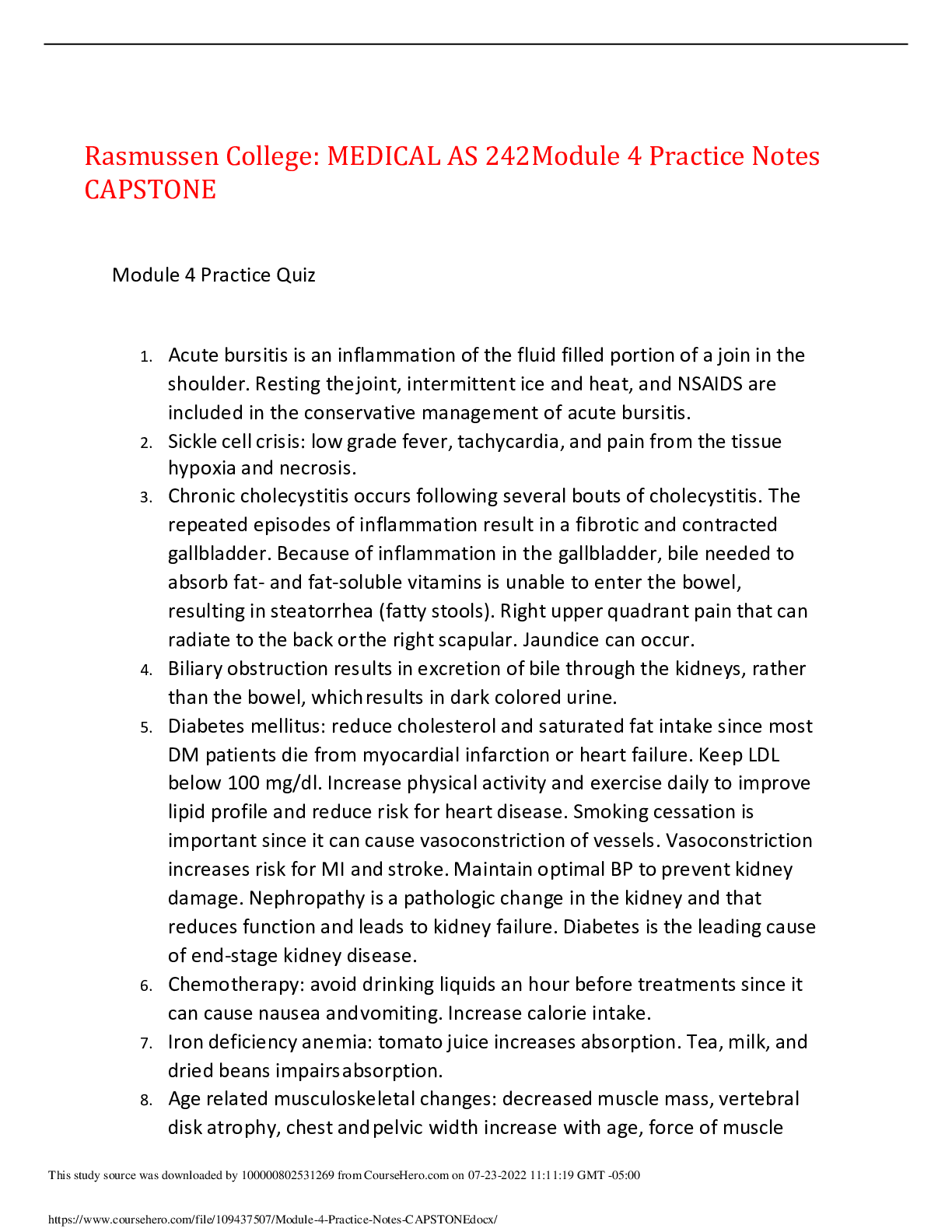




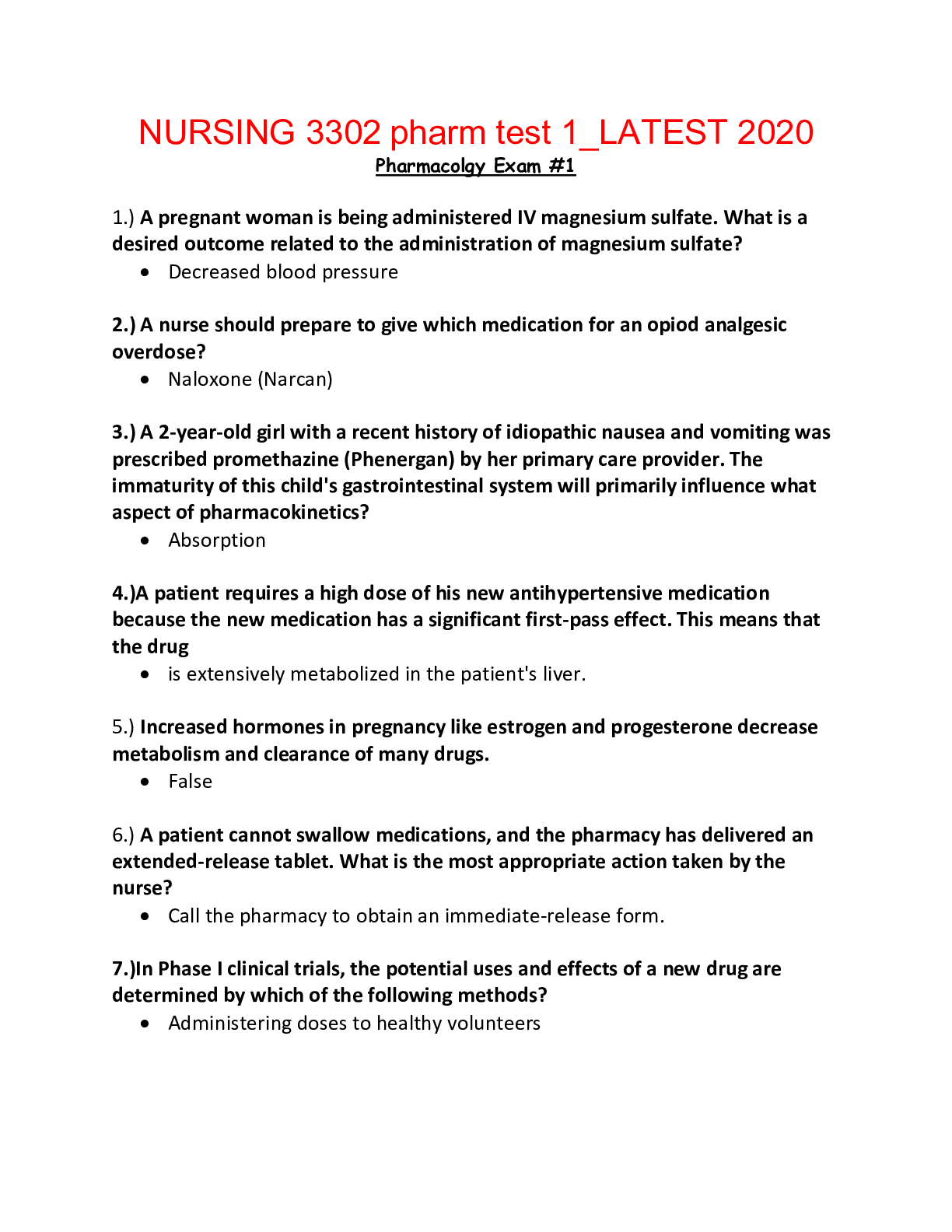
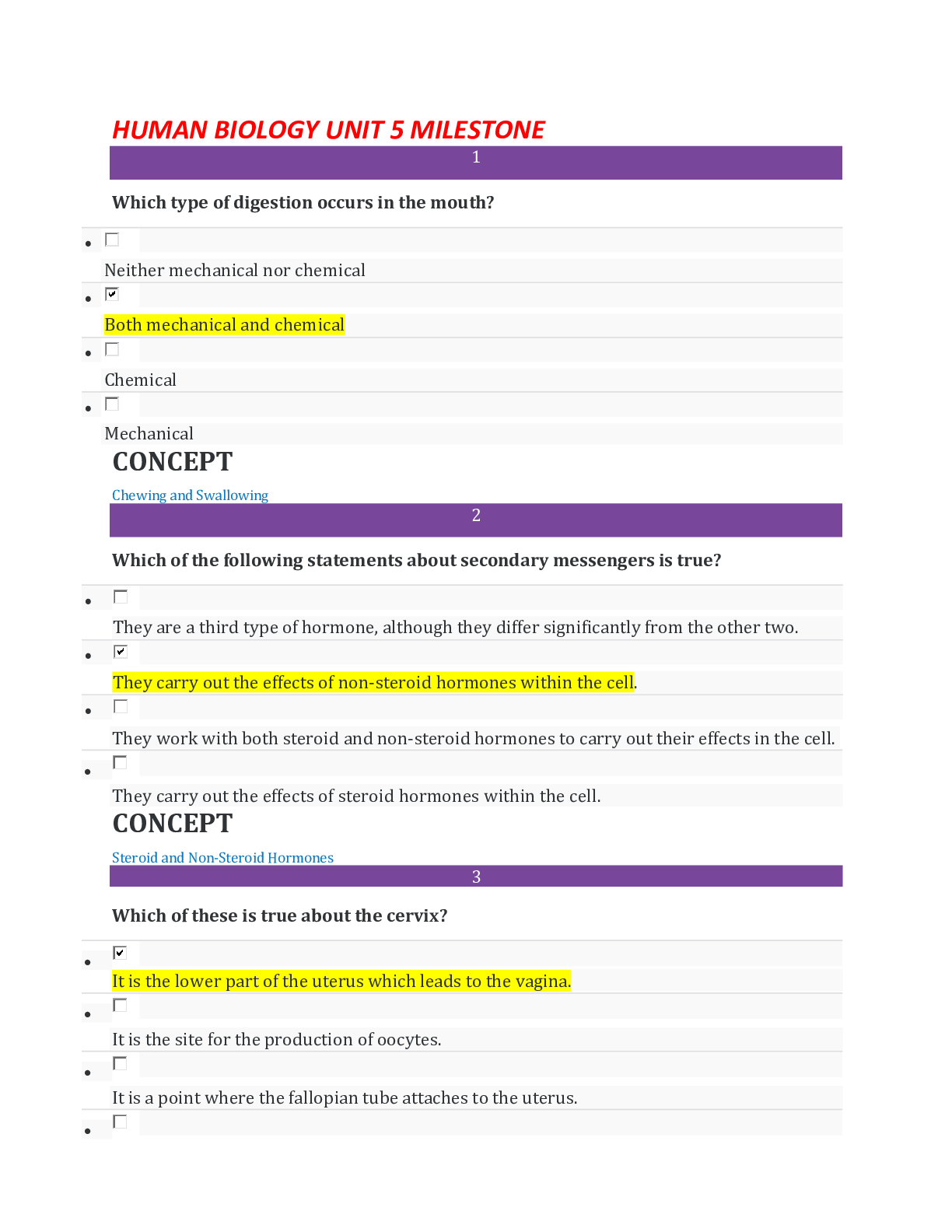
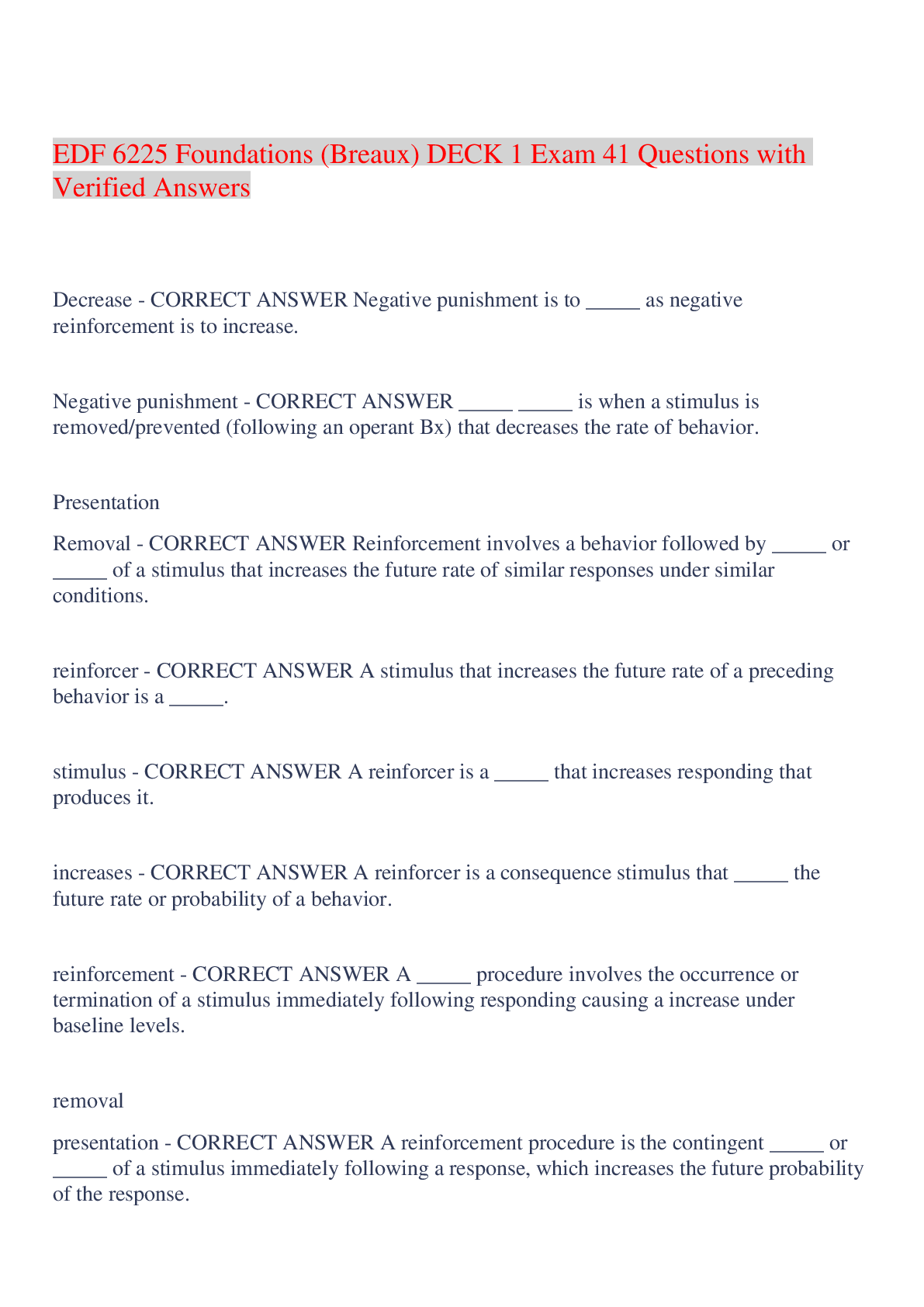

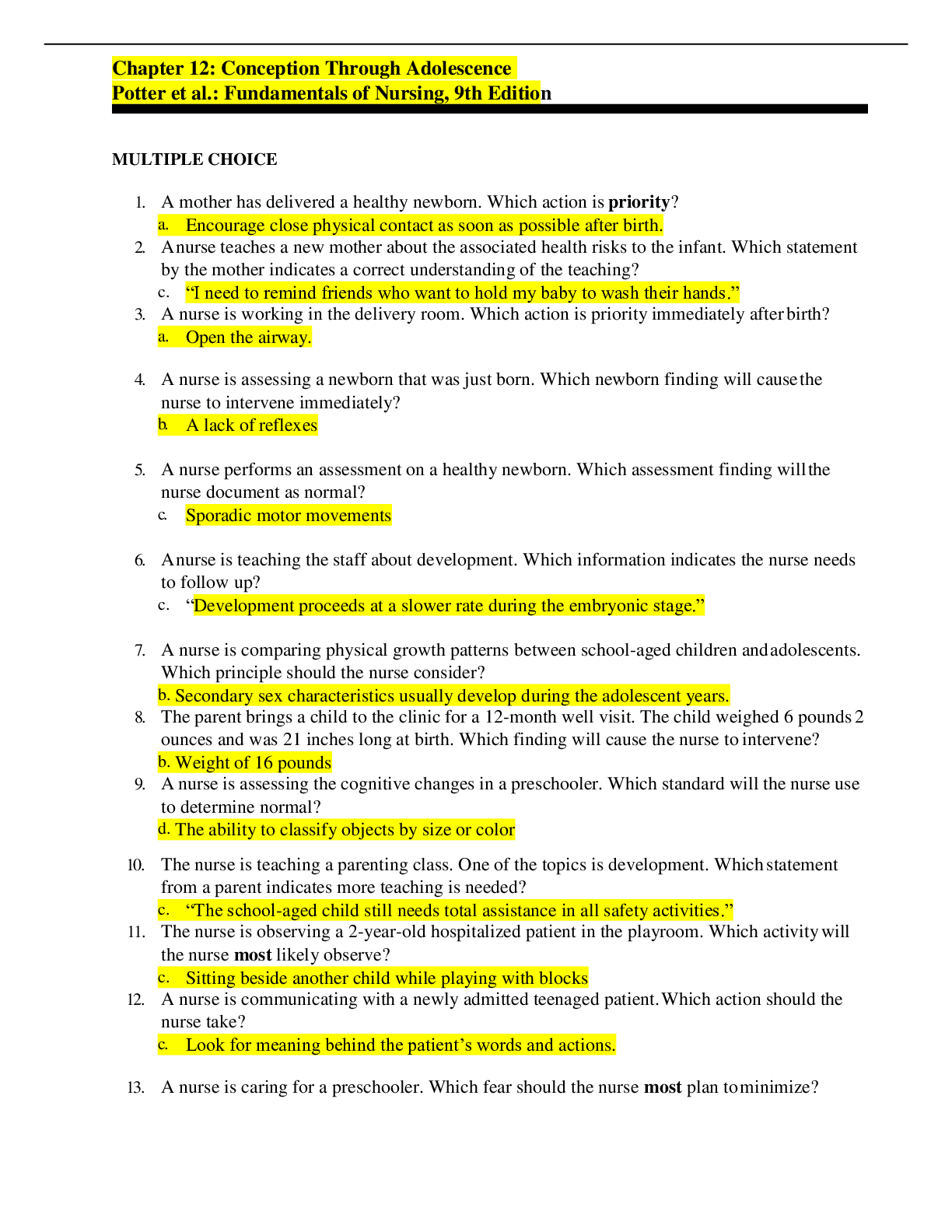
.png)
.png)


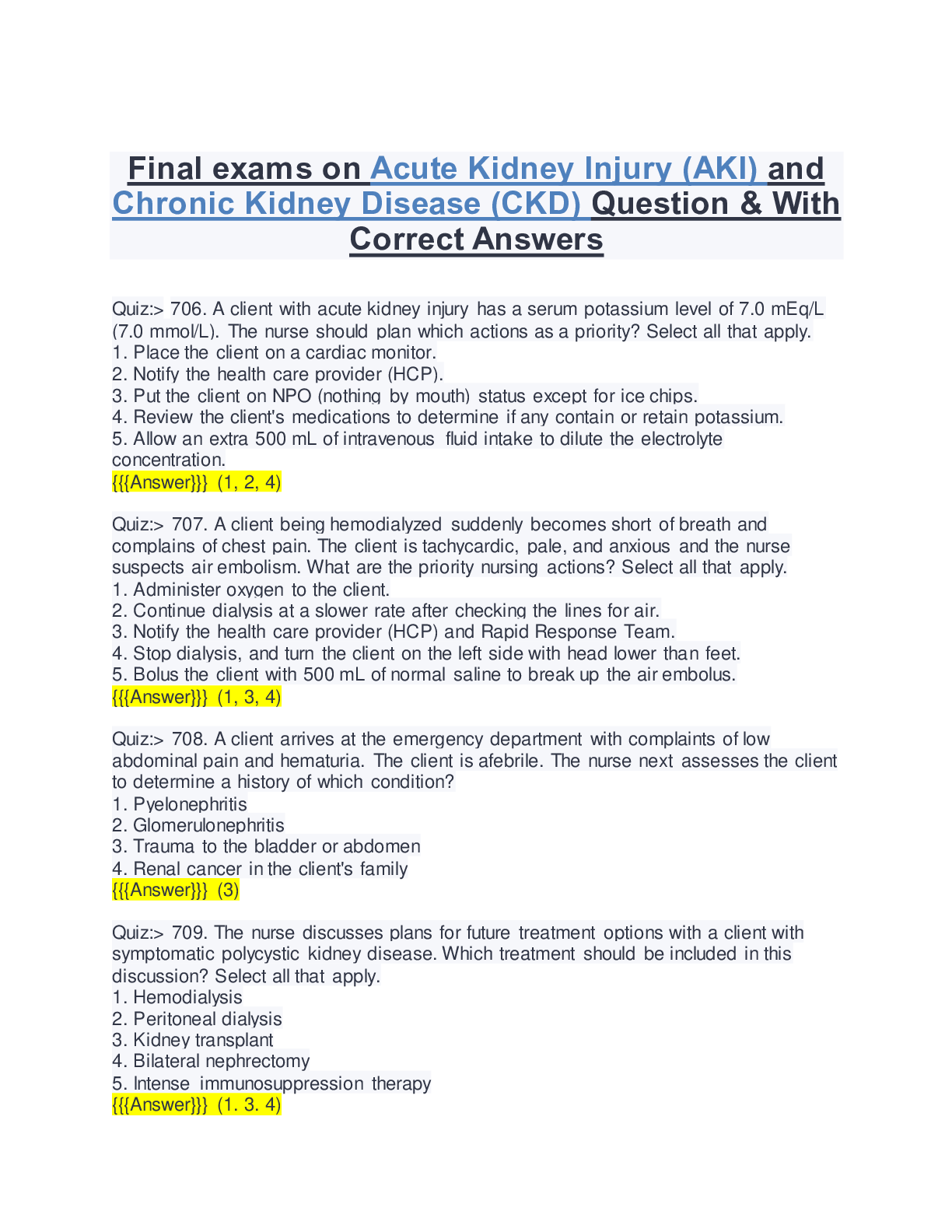

.png)




